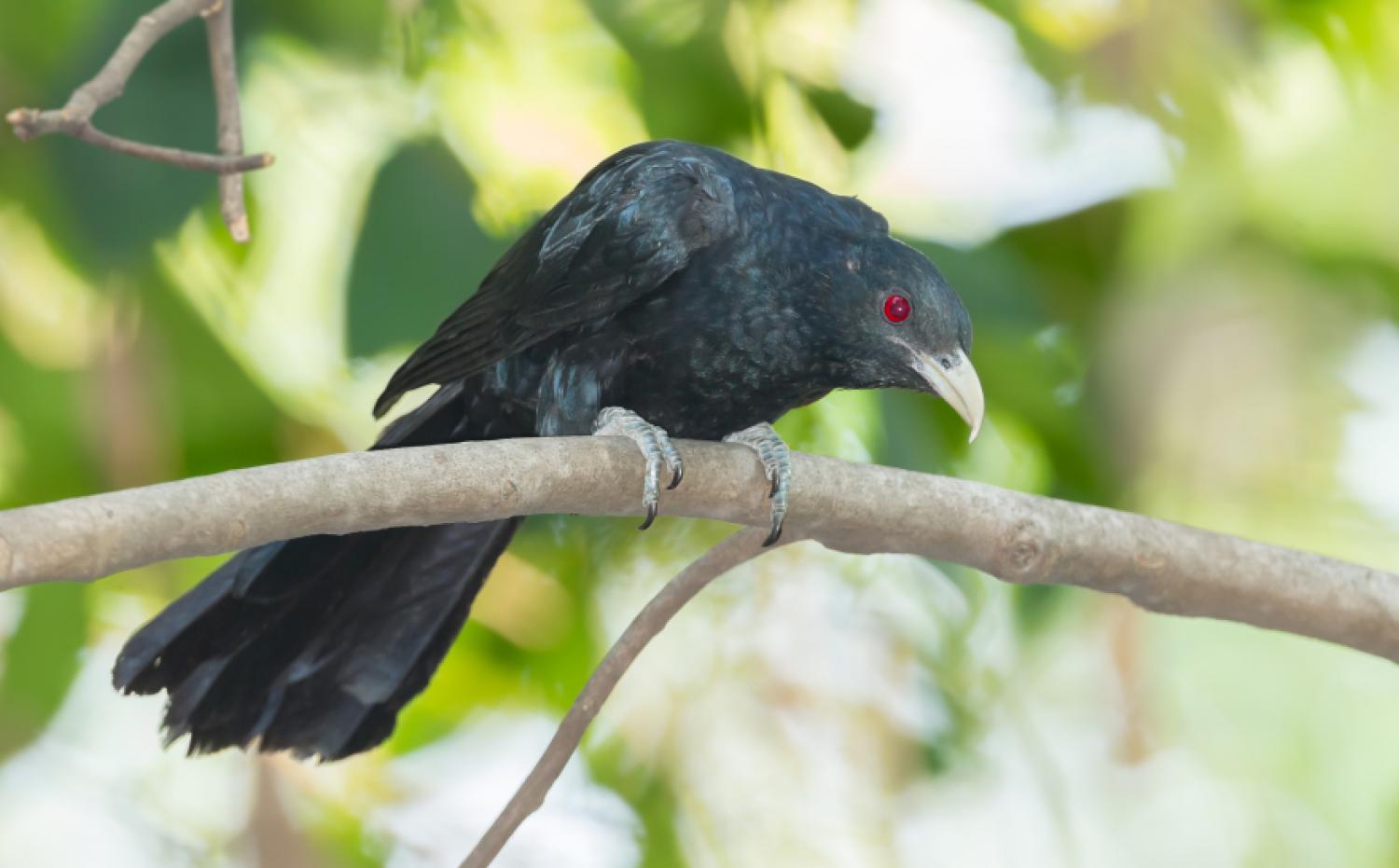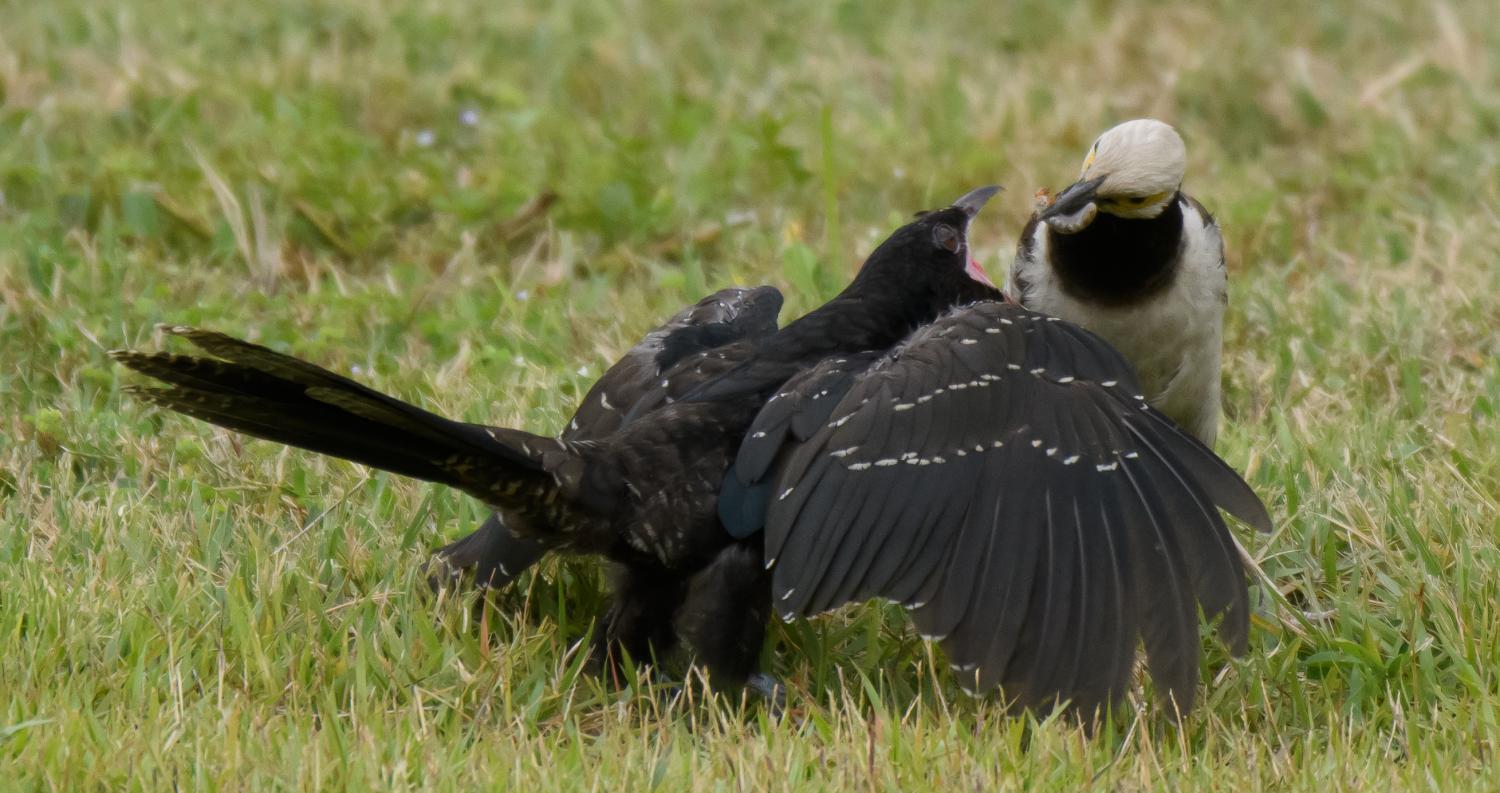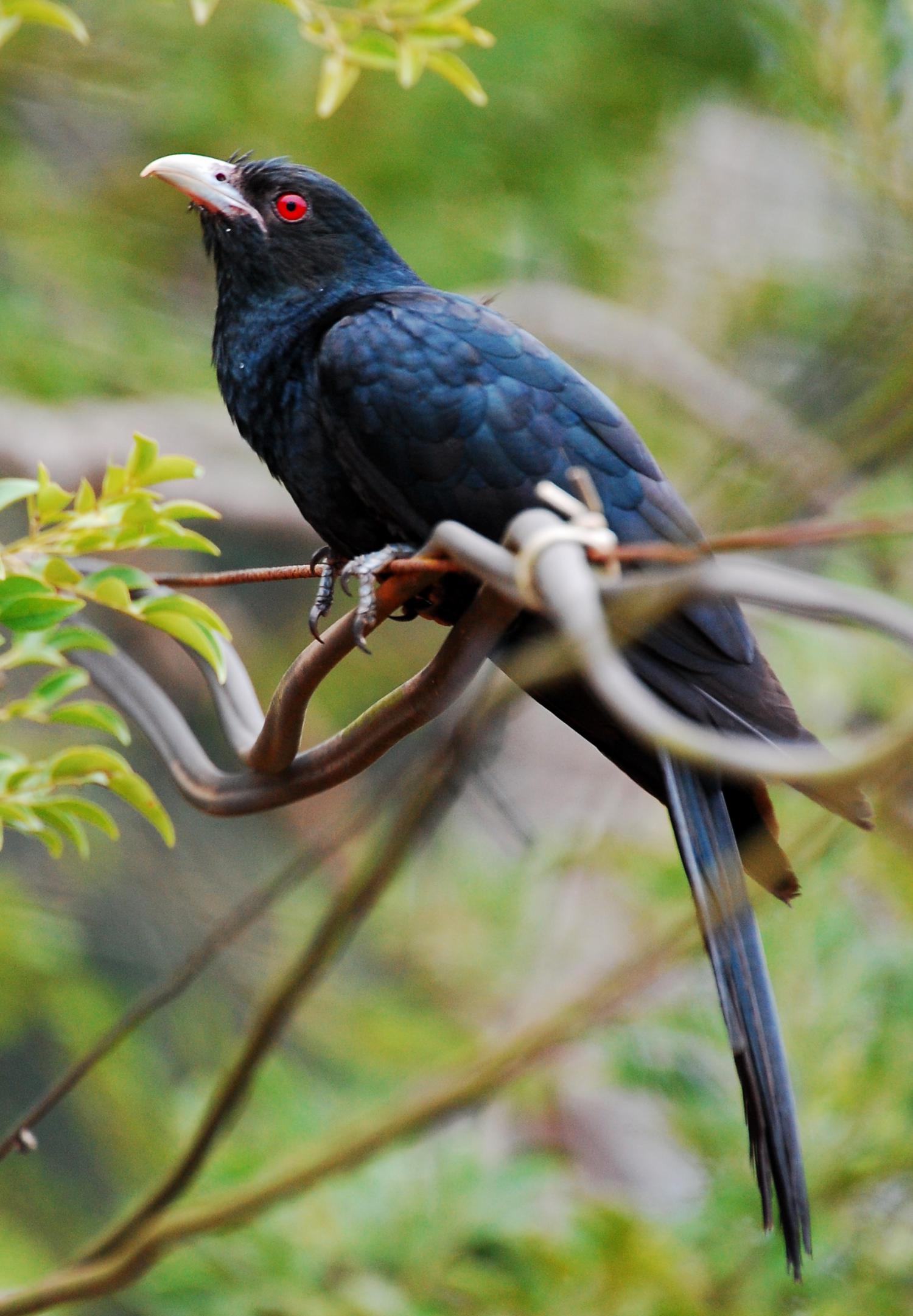Species of Thailand
Asian koel
Eudynamys scolopaceus
Carolus Linnaeus, 1758
In Thai: นกกาเหว่า
The Asian koel (Eudynamys scolopaceus) is a member of the cuckoo order of birds, the Cuculiformes. It is found in the Indian Subcontinent, China, and Southeast Asia. It forms a superspecies with the closely related black-billed koels, and Pacific koels which are sometimes treated as subspecies. The Asian koel like many of its related cuckoo kin is a brood parasite that lays its eggs in the nests of crows and other hosts, who raise its young. They are unusual among the cuckoos in being largely frugivorous as adults. The name koel is echoic in origin with several language variants. The bird is a widely used symbol in Indian poetry.
Description
The Asian koel is a large, long-tailed, cuckoo measuring 39 - 46 cm and weighing 190 - 327 g. The male of the nominate race is glossy bluish-black, with a pale greenish grey bill, the iris is crimson, and it has grey legs and feet. The female of the nominate race is brownish on the crown and has rufous streaks on the head. The back, rump and wing coverts are dark brown with white and buff spots. The underparts are whitish, but is heavily striped. The other subspecies differ in colouration and size. The upper plumage of young birds is more like that of the male and they have a black beak.
They are very vocal during the breeding season (March to August in the Indian Subcontinent), with a range of different calls. The familiar song of the male is a repeated koo-Ooo. The female makes a shrill kik-kik-kik... call. Calls vary across populations.
They show a pattern of moult that differs from those of other parasitic cuckoos. The outer primaries show a transilient (alternating) ascending moult (P9-7-5-10-8-6) while the inner primaries are moulted in stepwise descending order (1-2-3-4).(Payne citing Stresemann and Stresemann 1961)
Taxonomy
The Asian koel was originally described by Carl Linnaeus as Cuculus scolopaceus based on a specimen he received from the Malabar region. The species has variations within its wide range with several island populations and a number of taxonomic variations have been suggested. The black-billed koel (E. melanorhynchus) of the Sulawesi region and the Pacific koel of Australasia are sometimes considered conspecific with the Asian koel in which case the "combined" species is known as the common koel. Due to differences in plumage, colour of bill and voice, the three are increasingly treated as separate species. Alternatively, only the black-billed koel has been considered as a separate species, or the Asian koel has included all subspecies otherwise included in the Pacific koel, except for the subspecies breeding in Australia, which then has the name Australian koel (E. cyanocephalus).
The Asian koel has several geographic forms that have well marked plumage differences or have been geographically isolated with little gene flow. The following is a list of named subspecies with their distributions and synonyms as given by Payne:
- Eudynamys scolopaceus scolopaceus (Linnaeus, 1758). Pakistan, India, Nepal, Bangladesh, Sri Lanka, Laccadives and Maldives.
- Eudynamys scolopaceus chinensis (Cabanis and Heine, 1863). Southern China and Indochina, except the Thai-Malay Peninsula.
- Eudynamys scolopaceus harterti (Ingram, 1912). Hainan.
- Eudynamys scolopaceus malayana (Cabanis and Heine, 1863). Thai-Malay Peninsula, Lesser Sundas and Greater Sundas, except Sulawesi. This may include the race dolosa described from the Andaman and Nicobar Islands.
- Eudynamys scolopaceus mindanensis (Linnaeus, 1766) (includes E. s. paraguena) (Hachisuka, 1934) from Palawan, and E. s. corvina (Stresemann, 1931) from Halmahera, the Philippines (including Palawan and the Babuyan Islands), islands between Mindanao and Sulawesi, and North Maluku, except the Sula Islands.
Distribution and habitat
The Asian koel is a bird of light woodland and cultivation. It is a mainly resident breeder in tropical southern Asia from Iran, India, Bangladesh and Sri Lanka to southern China and the Greater Sundas. They have great potential in colonizing new areas, and were among the pioneer birds to colonize the volcanic island of Krakatau. They first arrived in Singapore in the 1980s and became very common birds.
Some populations may make long-distance movements being found in places like Australia.
Behaviour
The Asian koel is a brood parasite, and lays its single egg in the nests of a variety of birds, including the jungle crow, and house crow. In Sri Lanka before 1880 it was only known to parasitize the jungle crow, later shifting to the house crow. A study in India found 5% of Corvus splendens and 0.5% of Corvus macrorhynchos nests parasitized.
In Bangladesh, they parasitise long-tailed shrike (Lanius schach), common myna (Acridotheres tristis) and house crows (Corvus splendens) at about 35.7, 31.2 and 10.8% rates respectively. Host nests at low heights and nearer to fruit trees tended to be preferred by koels. In southern Thailand and the Malay Peninsula, koels have shifted host from crows to mynas (Acridotheres sp.) as the latter became more common in the late 1900s. In the Indian Subcontinent they have sometimes been found to parasitize the black drongo, the European magpie and possibly the black-headed oriole. Males may distract the hosts so that the female gets a chance to lay an egg in the nest. More often however, the female visits the nest of the host alone. The koel is not known to lay eggs in an empty host nest and a study in Pakistan found that the first koel eggs were laid, on average, within one and half days of the laying of the host's first egg. The chicks of the koel hatched about 3 days ahead of the host chicks. Koels usually lay only an egg or two in a single nest but as many as seven to eleven eggs have been reported from some host nests. A female may remove a host egg before laying. Eggs hatch in 12 to 14 days. The young koel does not always push out eggs or evict the host chicks, and initially calls like a crow. The young fledge in 20 to 28 days. Unlike some other cuckoos, the young do not attempt to kill the host chicks, a trait that is shared with the channel-billed cuckoos which are also largely frugivorous as adults. It has been suggested that koels, like some other brood parasites do not evict the host chicks due presumably due to the higher cost of evicting nestmates. A small parasite may not be able to evict large host eggs or chicks from a deep Corvid nest without risking starvation and possibly accidental self-eviction. An alternative hypothesis that retaining host chicks might benefit the koel chicks did not gain much support. Adult female parents have been known to feed young koels in the nests of the hosts, a behaviour seen in some other brood parasitic species as well. Adult males have however not been noted to feed fledglings.
The Asian koel is omnivorous, consuming a variety of insects, caterpillars, eggs and small vertebrates. Adults feed mainly on fruit. They will sometimes defend fruiting trees that they forage in and chase away other frugivores. They have been noted to be especially important in the dispersal of the sandalwood tree (Santalum album) in India. Large seeded fruits are sometimes quickly regurgitated near the parent tree while small seeded fruits are ingested and are likely to be deposited at greater distances from the parent tree. They have a large gape and are capable of swallowing large fruits including the hard fruit of palms such as Arenga and Livistona. They have been known to occasionally take eggs of small birds.
They feed on the fruits of Cascabela thevetia which are known to be toxic to mammals.
A number of parasites of the species have been described, including malaria-like protozoa, lice and nematodes.
In culture
The word "koel" is onomatopoeic in origin. The Sanskrit name of "Kokila" and words in several Indian languages are similarly echoic. Being familiar birds with loud calls, references to them are common in folklore, myth and poetry. It is traditionally held in high regard for its song and revered in the Manusmriti, an ancient decree protecting them from harm. The Vedas, Sanskrit literature dated to about 2000 BC referred to it as Anya-Vapa which has been translated as "that which was raised by others" (or "sown for others to reap"). This has been interpreted as the earliest knowledge of brood parasitism. It has been chosen as the state bird by the Indian union territory of Puducherry.
These birds were once very popular in India as cagebirds. Feeding even on boiled rice, these hardy birds lived in captivity for as long as 14 years.
This article uses material from Wikipedia released under the Creative Commons Attribution-Share-Alike Licence 3.0. Eventual photos shown in this page may or may not be from Wikipedia, please see the license details for photos in photo by-lines.
Category / Seasonal Status
BCST Category: Recorded in an apparently wild state within the last 50 years
BCST Seasonal status: Resident or presumed resident
Scientific classification
- Kingdom
- Animalia
- Phylum
- Chordata
- Class
- Aves
- Order
- Cuculiformes
- Family
- Cuculidae
- Genus
- Eudynamys
- Species
- Eudynamys scolopaceus
Common names
- Thai: นกกาเหว่า
Synonyms
- Eudynamys scolopacea
- Eudynamis honorata
- Cuculus scolopaceus
Conservation status

Least Concern (IUCN3.1)
Photos
Please help us review the bird photos if wrong ones are used. We can be reached via our contact us page.
Range Map

- Amphawa District, Samut Songkhram
- Ao Phang-Nga National Park
- Ban Bueng District, Chonburi
- Ban Laem District, Phetchaburi
- Ban Lat District, Phetchaburi
- Ban Phai District, Khon Kaen
- Ban Pho District, Chachoengsao
- Ban Phraek District, Phra Nakhon Si Ayutthaya
- Ban Sang District, Prachinburi
- Bang Ban District, Phra Nakhon Si Ayutthaya
- Bang Kruai District, Nonthaburi
- Bang Lamung District, Chonburi
- Bang Len District, Nakhon Pathom
- Bang Pa In District, Phra Nakhon Si Ayutthaya
- Bang Pahan District, Phra Nakhon Si Ayutthaya
- Bang Pakong District, Chachoengsao
- Bang Phra Non-Hunting Area
- Bang Pu Recreation Centre
- Bang Saphan Noi District, Prachuap Khiri Khan
- Bangkok Province
- Borabue District, Maha Sarakham
- Bueng Boraped Non-Hunting Area
- Chaiya District, Surat Thani
- Chaiyo District, Ang Thong
- Chaloem Phra Kiat District, Saraburi
- Chatturat District, Chaiyaphum
- Chiang Dao District, Chiang Mai
- Chiang Dao Wildlife Sanctuary
- Chiang Khong District, Chiang Rai
- Chiang Saen District, Chiang Rai
- Dan Sai District, Loei
- Doi Inthanon National Park
- Doi Lo District, Chiang Mai
- Doi Pha Hom Pok National Park
- Doi Saket District, Chiang Mai
- Doi Suthep - Pui National Park
- Don Chedi District, Suphan Buri
- Dong Kheng Forest Park
- Erawan National Park
- Fang District, Chiang Mai
- Hala-Bala Wildlife Sanctuary
- Hat Yai District, Songkhla
- Huai Chorakhe Mak Reservoir Non-Hunting Area
- Huai Kha Khaeng Wildlife Sanctuary
- Huai Krachao District, Kanchanaburi
- Huai Sala Wildlife Sanctuary
- Huai Talat Reservoir Non-Hunting Area
- In Buri District, Sing Buri
- Kabin Buri District, Prachinburi
- Kaeng Khoi District, Saraburi
- Kaeng Khro District, Chaiyaphum
- Kaeng Krachan District, Phetchaburi
- Kaeng Krachan National Park
- Kamphaeng Saen District, Nakhon Pathom
- Kanthararom District, Sisaket
- Kantharawichai District, Maha Sarakham
- Kaset Sombun District, Chaiyaphum
- Khanom District, Nakhon Si Thammarat
- Khao Ang Rue Nai Wildlife Sanctuary
- Khao Banthat Wildlife Sanctuary
- Khao Khitchakut National Park
- Khao Laem National Park
- Khao Laem Ya - Mu Ko Samet National Park
- Khao Lak - Lam Ru National Park
- Khao Luang National Park
- Khao Nang Phanthurat Forest Park
- Khao Phanom Bencha National Park
- Khao Phra - Bang Khram Wildlife Sanctuary
- Khao Sam Roi Yot National Park
- Khao Sanam Prieng Wildlife Sanctuary
- Khao Soi Dao Wildlife Sanctuary
- Khao Sok National Park
- Khao Yai National Park
- Khao Yoi District, Phetchaburi
- Khlong Hoi Khong District, Songkhla
- Khlong Lan National Park
- Khlong Luang District, Pathum Thani
- Khok Sung District, Sa Kaeo
- Khuan Khanun District, Phatthalung
- Khun Chae National Park
- Khun Tan District, Chiang Rai
- Khung Kraben Non-Hunting Area
- Khura Buri District, Phang Nga
- Klaeng District, Rayong
- Ko Chang National Park
- Ko Lanta National Park
- Ko Libong
- Ko Samui District, Surat Thani
- Ko Sichang District, Chonburi
- Ko Tao
- Kromluang Chumphon Wildlife Sanctuary
- Kui Buri National Park
- Kumphawapi District, Udon Thani
- Laem Pak Bia
- Laem Son National Park
- Lam Nam Kok National Park
- Mae Ai District, Chiang Mai
- Mae Mo District, Lampang
- Mae Ping National Park
- Mae Rim District, Chiang Mai
- Mae Sai District, Chiang Rai
- Mae Taeng District, Chiang Mai
- Mae Wong National Park
- Mu Ko Chumphon National Park
- Muak Lek District, Saraburi
- Mueang Buriram District, Buriram
- Mueang Chachoengsao District, Chachoengsao
- Mueang Chaiyaphum District, Chaiyaphum
- Mueang Chiang Mai District, Chiang Mai
- Mueang Chiang Rai District, Chiang Rai
- Mueang Chonburi District, Chonburi
- Mueang Chumphon District, Chumphon
- Mueang Kalasin District, Kalasin
- Mueang Kamphaeng Phet District, Kamphaeng Phet
- Mueang Kanchanaburi District, Kanchanaburi
- Mueang Khon Kaen District, Khon Kaen
- Mueang Krabi District, Krabi
- Mueang Lampang District, Lampang
- Mueang Lamphun District, Lamphun
- Mueang Lopburi District, Lopburi
- Mueang Maha Sarakham District, Maha Sarakham
- Mueang Nakhon Nayok District, Nakhon Nayok
- Mueang Nakhon Pathom District, Nakhon Pathom
- Mueang Nakhon Ratchasima District, Nakhon Ratchasima
- Mueang Nakhon Si Thammarat District, Nakhon Si Thammarat
- Mueang Nan District, Nan
- Mueang Nonthaburi District, Nonthaburi
- Mueang Pathum Thani District, Pathum Thani
- Mueang Pattani District, Pattani
- Mueang Phang Nga District, Phang Nga
- Mueang Phatthalung District, Phatthalung
- Mueang Phetchabun District, Phetchabun
- Mueang Phetchaburi District, Phetchaburi
- Mueang Phichit District, Phichit
- Mueang Phitsanulok District, Phitsanulok
- Mueang Phuket District, Phuket
- Mueang Prachinburi District, Prachinburi
- Mueang Prachuap Khiri Khan District, Prachuap Khiri Khan
- Mueang Ratchaburi District, Ratchaburi
- Mueang Rayong District, Rayong
- Mueang Sa Kaeo District, Sa Kaeo
- Mueang Samut Sakhon District, Samut Sakhon
- Mueang Samut Songkhram District, Samut Songkhram
- Mueang Saraburi District, Saraburi
- Mueang Satun District, Satun
- Mueang Songkhla District, Songkhla
- Mueang Sukhothai District, Sukhothai
- Mueang Suphanburi District, Suphan Buri
- Mueang Surat Thani District, Surat Thani
- Mueang Surin District, Surin
- Mueang Tak District, Tak
- Mueang Udon Thani District, Udon Thani
- Mueang Uttaradit District, Uttaradit
- Nam Nao National Park
- Nam Phong National Park
- Non Din Daeng District, Buriram
- Non Thai District, Nakhon Ratchasima
- Nong Bong Khai Non-Hunting Area
- Nong Song Hong District, Khon Kaen
- Nong Suea District, Pathum Thani
- Nong Ya Plong District, Phetchaburi
- Nong Yai Area Development Project Under Royal Init
- Op Khan National Park
- Pa Sang District, Lamphun
- Pai District, Mae Hong Son
- Pak Chong District, Nakhon Ratchasima
- Pak Kret District, Nonthaburi
- Pak Phanang District, Nakhon Si Thammarat
- Pak Phli District, Nakhon Nayok
- Pak Thale
- Pak Tho District, Ratchaburi
- Pak Thong Chai District, Nakhon Ratchasima
- Pang Sida National Park
- Pang Sila Thong District, Kamphaeng Phet
- Pha Daeng National Park
- Pha Hin Ngam National Park
- Phaisali District, Nakhon Sawan
- Phan District, Chiang Rai
- Phanat Nikhom District, Chonburi
- Phatthana Nikhom District, Lopburi
- Phi Phi Islands
- Phimai District, Nakhon Ratchasima
- Pho Prathap Chang District, Phichit
- Phra Nakhon Si Ayutthaya District, Phra Nakhon Si Ayutthaya
- Phu Sa Dok Bua National Park
- Phu Suan Sai National Park
- Phu Wiang National Park
- Phutthamonthon District, Nakhon Pathom
- Pran Buri District, Prachuap Khiri Khan
- Pran Buri Forest Park
- Ramkhamhaeng National Park
- Ratchasan District, Chachoengsao
- Sai Noi District, Nonthaburi
- Sai Yok District, Kanchanaburi
- Sai Yok National Park
- Sakaerat Environmental Research Station
- Samae San Island
- Samut Prakan Province
- San Kala Khiri National Park
- San Sai District, Chiang Mai
- Sanam Bin Reservoir Non-Hunting Area
- Sanam Chai Khet District, Chachoengsao
- Sankhaburi District, Chainat
- Sattahip District, Chonburi
- Satuek District, Buriram
- Sawi District, Chumphon
- Si Racha District, Chonburi
- Si Satchanalai District, Sukhothai
- Similan Islands
- Sirinat National Park
- Sri Nakarin Dam National Park
- Sri Phang-nga National Park
- Su-ngai Kolok District, Narathiwat
- Sukhirin District, Narathiwat
- Surin Islands
- Ta Phraya National Park
- Takua Pa District, Phang Nga
- Taphan Hin District, Phichit
- Tarutao National Marine Park
- Tha Chang District, Sing Buri
- Tha Phae District, Satun
- Tha Sala District, Nakhon Si Thammarat
- Tha Takiap District, Chachoengsao
- Tha Wung District, Lopburi
- Tha Yang District, Phetchaburi
- Thai Mueang District, Phang Nga
- Thalang District, Phuket
- Thale Noi Non-Hunting Area
- Than Sadet - Koh Pha-Ngan National Park
- Thanyaburi District, Pathum Thani
- Thao Kosa Forest Park
- Thap Lan National Park
- Thawat Buri District, Roi Et
- Thung Yai Naresuan Wildlife Sanctuary
- Wang Chan District, Rayong
- Wang Nam Yen District, Sa Kaeo
- Wang Noi District, Phra Nakhon Si Ayutthaya
- Wapi Pathum District, Maha Sarakham
- Wat Phai Lom & Wat Ampu Wararam Non-Hunting Area
- Wat Tham Erawan Non-Hunting Area
- Watthana Nakhon District, Sa Kaeo
- Wiang Chai District, Chiang Rai
- Wiang Kaen District, Chiang Rai
- Yan Ta Khao District, Trang
- Yang Talat District, Kalasin



